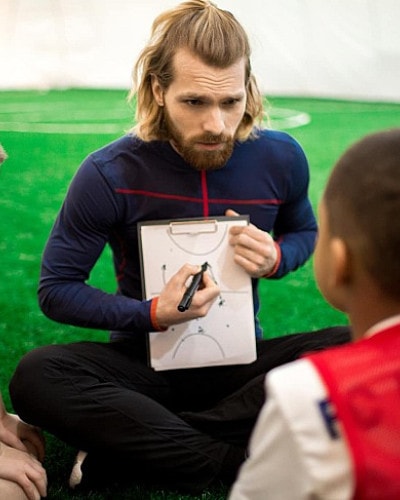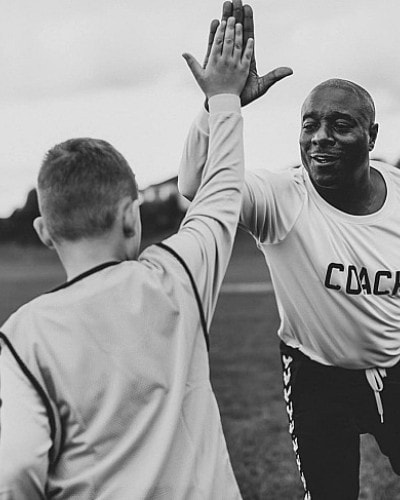Key Player Archetypes in Football: Building a Balanced Team
A football team consists of 11 players, divided into goalkeeper, defense, midfield, and attack. That much is clear. However, just like in any successful team—whether in sports or the workplace—having a mix of different character types is crucial. A variety of playing styles and mentalities helps amplify strengths while covering weaknesses, ensuring better overall performance.
This article focuses not on positions but rather on the different player archetypes that make up a well-rounded squad.
#1 The Leader
Every team needs a strong leader—an authoritative figure who takes charge, motivates, and keeps the squad organized on the field. Acting as the coach’s right-hand man, the leader ensures that tactical discipline, communication, and morale remain high. This player’s influence extends beyond the pitch, as they often serve as the team captain, making crucial decisions and setting the tone for the game.
Having a dominant leader is invaluable for any coach, as they can rely on this figure to enforce the team’s game plan, drive motivation, and maintain team spirit.
Notable examples: Oliver Kahn, Roy Keane, Sergio Ramos
#2 The Brain (Playmaker)
This player is the tactical heartbeat of the team. Most attacking plays flow through them, as they dictate the tempo, distribute passes, and orchestrate build-up play. Often highly skilled technically, they possess excellent vision and composure, making them a calming influence when the opposition applies pressure.
The brain is typically positioned in central midfield, controlling the game from deep or advanced areas.
Notable examples: Xavi, Zinedine Zidane, Luka Modrić
#3 The Artist (Flair Player)
This is the player who brings creativity, unpredictability, and magic to the game. Known for their exceptional dribbling, vision, and goal-scoring ability, the artist thrives on offensive freedom, creating chances through individual brilliance. They are often the most exciting players to watch, dazzling crowds with skills and moments of genius.
However, artists can also be inconsistent and emotionally driven. If things don’t go their way, their influence on the game can diminish quickly.
Notable examples: Lionel Messi, Ronaldinho, Neymar
#4 The Warrior (Enforcer)
A warrior is willing to do the dirty work. This player is physical, aggressive, and relentless in winning duels. Strong in the tackle, tough in aerial battles, and tireless in covering ground, the enforcer provides defensive stability and allows more creative teammates to shine.
They are usually deployed in defensive midfield, shielding the backline and disrupting the opponent’s attacks. In set-piece situations, they are crucial in both defense and attack due to their strength and aerial ability.
Notable examples: N’Golo Kanté, Casemiro, Gennaro Gattuso
#5 The Engine (Workhorse)
This player is the team’s endurance machine, running tirelessly from start to finish. Their high work rate benefits both defense and attack, creating numerical superiority in key areas of the pitch. The engine contributes defensively by tracking back and pressing opponents, while offensively, they offer an extra passing option and create space.
Similar in mentality to the warrior, the engine is often found in central midfield or as a wide player.
Notable examples: James Milner, Bastian Schweinsteiger, Dirk Kuyt
#6 The Swiss Army Knife (Versatile Player)
Versatility is a highly valuable asset in any squad. The all-rounder is capable of playing in multiple positions without significantly weakening the team. They might not be the best in any single area, but their adaptability makes them essential in covering injuries, suspensions, or tactical changes.
All-rounders often combine multiple traits from other player types, making them reliable and indispensable team members.
Notable examples: Cristiano Ronaldo (attacking versatility), David Alaba (defensive versatility), Thiago Alcântara (midfield versatility)
Conclusion
An ideal football team should include a mix of these player types to achieve balance and success. However, certain archetypes should not be overrepresented.
For instance, a team needs only one or two strong leaders to maintain structure without clashing egos. Likewise, an excess of playmakers (brains) might lead to a lack of physical presence or defensive discipline.
It is the coach’s responsibility to recognize these player types and form a lineup where strengths complement each other. The right combination of personalities and playing styles enhances team chemistry, maximizes performance, and ultimately increases the chances of success on the pitch.






